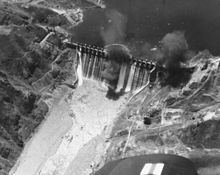Official name 화천댐 Length 435 m (1,427 ft) Opened 1944 Construction began 1939 | Country South Korea Opening date 1944 Height 82 m Catchment area 3,901 km² | |
 | ||
Spillway capacity 5,428 m/s (191,688 cu ft/s) Province Gangwon Province, South Korea Owner Korea Hydro & Nuclear Power Similar | ||
Hwacheon Dam is a concrete gravity dam on the North Han (Pukhan) River in Hwacheon County, Gangwon-do Province, South Korea. The dam was completed in 1944 as a primary source of electricity in southern Korea. It was the focal point of a raid during the Korean War and also provides flood protection from North Korea's Imnam Dam upstream.
Contents
Map of Hwacheon Dam, Hwacheon-eup, Hwacheon
Background
The dam was constructed by the Japanese during their occupation of Korea in World War II. The Han River Hydroelectric Company began construction in July 1939 and the dam was complete in October 1944. Several months prior in May, the first generator of the power plant was operational, the second that October. The third generator was operational in 1957 and the last of the four generators was installed in 1968. Before the upstream Peace Dam was completed in 2005, the Hwacheon Dam served as the first line-of-defense for a collapse or excess discharge from the Imnam Dam in North Korea.
Korean War raid
At midnight 8 April 1951, North Korea and Chinese forces released excess water from the dam's spillway which disabled five floating bridges of the United Nations Command downstream. The dam was previously assessed as a problem and key facility in the area due to its hydroelectric power and ability to flood downstream areas. Capturing or disabling it became key. On 9 April, the 7th Cavalry Regiment, already executing Operation Rugged in the area, were charged with capturing the dam but were unsuccessful after encountering stiff defense. Between 16 and 21 April, Allies had secured the dam but were repelled by Chinese counterattack before being able to destroy the dam's floodgates. After B-29s failed to neutralize the dam, on 30 April, Skyraiders fired Tiny Tim rockets at and dropped a pair of 2,000-pound bombs on the dam, puncturing one spillway gate. On 1 May, Air Group 19 assaulted the dam with eight Skyraiders that were equipped with Mk 13 torpedoes and escorted by twelve Corsairs. Seven of eight torpedoes struck the dam and six exploded. The attack alleviated the dam as a flood threat, destroying one sluice gate and damaging several others. One of the participating U.S. Navy squadrons, VA-195 was renamed from Tigers to Dambusters. This raid constitutes the last time globally that an aerial torpedo was used against a surface target, and was the only time torpedoes were used in the Korean War.
Design
The dam is a 78 m (256 ft) tall and 435 m (1,427 ft) long concrete gravity-type. The dam sits at the head of a 3,901 km2 (1,506 sq mi) catchment area and its reservoir has a gross capacity of 1,018,000,000 m3 (825,306 acre·ft). Of this capacity, 809 million m3 can be regulated and 213 million m3 is used for flood control. The reservoir's surface area is 38.9 km2 (15 sq mi). The dam's spillway is controlled by 16 sluice gates and has a maximum discharge capacity of 5,428 m3/s (191,688 cu ft/s). The dam's power station is located 2.5 km (2 mi) southwest of the dam at 38°05′56″N 127°45′44″E, just over a ridge. The power station contains four 27 MW turbine-generators and has an effective hydraulic head of 74.5 m (244 ft).
